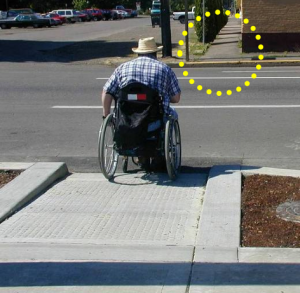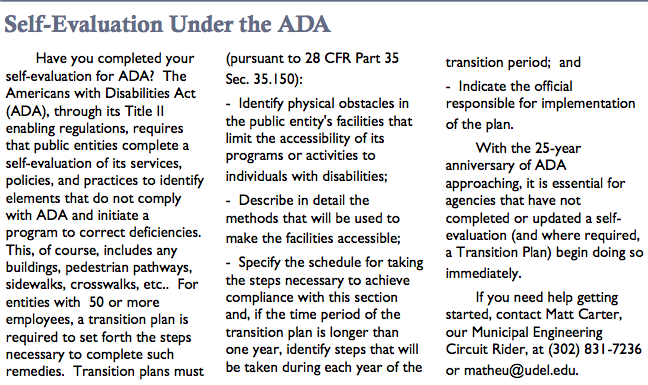Title II of the Americans with Disabilities Act (ADA) provides comprehensive civil rights protections for “qualified individuals with disabilities.” The Title II regulation covers “public entities,” which include any State or local government and any of its departments, agencies, or other instrumentalities. This section of the Toolbox provides an overview of ADA Title II requirements and the need for state and local governments to ensure that newly constructed buildings and facilities are free of barriers, and that individuals with disabilities are not excluded from services, programs, and activities because buildings are inaccessible.
Topics Covered
- The Americans with Disabilities Act: What is it?
- Local Government Steps to Achieve ADA Compliance
- ADA Facility Maintenance Requirements
The Americans with Disabilities Act: What is it?
According to its website, the Americans with Disabilities Act (ADA) is a federal civil rights law that became effective on July 26, 1990 in order to give equal opportunities to individuals with disabilities. It is a comprehensive civil rights law that prohibits “discrimination and ensur[es] equal opportunity for persons with disabilities in employment, state and local government services, public accommodations, commercial facilities, and transportation” and telecommunications.
Title II of ADA prohibits public entities—including state and local governments— from discrimination on the basis of disability. It states that persons with disabilities may not be excluded from participation in or be denied the benefits of the services, programs, or activities of a public entity, or be subjected to discrimination by any public entity. The act requires all public facilities and services to be readily accessible to and usable by individuals with disabilities, and addresses barriers to community services, transportation, and facilities.
Complete Communities allow for inclusive and active engagement of people of all ages and all abilities, regardless of their physical, ambulatory and/or low-vision limitations. Not only is compliance with ADA mandated by law, but public entities need to provide reasonable accommodations to people with a range of abilities to ensure equal access to government services, shopping, transportation, and facilities, as well as cultural, social, and recreational activities.
According to a 2012 United States Census Bureau Report on Americans with Disabilities, approximately 56.7 million people living in the U.S. had some type of disability in 2010, which represented about 19 percent of the non-institutionalized population. According to this report, the prevalence of disabilities increases with age.
The 2010 American Community Survey (ACS), estimates that there are 108,444 Delawareans with disabilities. The prevalence rate varies widely by age group: 31% for individuals 65 and over, 10.9% for those 18-64, and 4.4% for those under 18. It is estimated that by 2040, 30% of Delaware’s population will be over 60. A report issued by the Delaware State Housing Authority Delaware State Housing Authority states that individuals with any disability are projected to increase from 13.1% of Delaware’s population in 2010 to 16.8% of the population in 2040. Therefore, it is extremely important to ensure that government services, programs, facilities, and activities are accessible to and accommodate persons with disabilities.
Local Government Steps to Achieve ADA Compliance
Provisions of ADA must be met by local public agencies to be eligible for federal assistance and grants. State and local governments must identify barriers to accessibility, prioritize actions to address the barriers, and set forth a schedule for those actions. ADA Title II administrative requirements states, that public entities must take several steps designed to achieve compliance. These include the preparation of a self-evaluation. In addition, public entities with 50 or more employees are required to:
- Develop a grievance procedure;
- Designate an individual to oversee title II compliance;
- Develop a transition plan if structural changes are necessary for achieving program accessibility; and
- Retain the self-evaluation for three years.
Self-Evaluation
The first step to APA compliance is identifying barriers that prevent persons with disabilities from access to facilities, programs, services, and activities. Public entities must perform self-evaluations that assess the extent to which the jurisdiction’s services, programs, policies, and practices are compliant and provide equal access and opportunities for persons with disabilities. Public infrastructure and facilities must be accessible. Barriers within public right-of-way should be identified, including curbs, sidewalks, pedestrian crossings, pedestrian signals, shared-use trails, parking lots, and bus stops.
If an entity finds that their services are not compliant with ADA standards, “necessary modifications” must be made. The ADA states that during this process, a public entity shall allow stakeholders, including people with disabilities and organizations that represent people with disabilities, to provide feedback and comments on their current services.
Transition Plans
After completing a self-evaluation, a public entity is required to create a transition plan to address any issues. According to a presentation created by the Federal Highway Administration, this plan should include the findings of the self-evaluation, a description of the methods that will be used to correct noncompliance, and a thorough schedule to achieve these alterations. It is also important to estimate costs of these updates.
The National Cooperative Highway Research Program has published a Guide to Best Management Practices for ADA Transition Plans. While it is designed to provide state Departments of Transportation (DOTs) with successful practices to develop and update Transition Plans, the Guide may also be useful to local governments.
The Delaware Department of Transportation’s (DelDOT) ADA Self-Assessment and Transition Plan was formally adopted in May 2014 and may inform plans developed or updated by Delaware local governments. In this presentation, Transitioning to Accessibility, DelDOT ADA Title II Coordinator John McNeal discusses Delaware’s ADA Transition Plan.
ADA Coordinators
In addition to creating a transition plan, entities must appoint an ADA coordinator to ensure that the self-assessment and transition plan are carried out, published, and publicly available. ADA has prepared a State and Local Government ADA Best Practices Toolkit that provides information on administrative requirements of Title II of the ADA, including the mandates to designate an ADA coordinator, give notice about the ADA’s requirements, and establish a grievance procedure.
Process to Develop a Transition Plan
Public entities should take the following steps to develop an ADA Transition Plan:
- Identify the official responsible for developing and implementing the plan
- Establish a complaint procedure
- Adopt design standards, OR identify prescriptive federal and state design standards that will be followed
- Engage the community
- Develop a self-evaluation that includes:
- Necessary physical changes
- Prioritization of physical change
- Schedule physical changes and maintain documentation
- Make the self-evaluation and transition plan documents available for the public
ADA Facility Maintenance Requirements

Source: Designing Pedestrian Facilities for Accessibility, Delaware T2 Center
Under Title II of the ADA, state and local governments are required to ensure accessible design, construction, and maintenance, of all pedestrian facilities. Pedestrian facilities include public sidewalks, shared-use paths, trails, curb ramps, crosswalks, pedestrian islands, or other public walkways. DOJ’s ADA (2010) Standards for Accessible Design became mandatory on March 15, 2012. State and local government facilities must follow the requirements of the 2010 ADA Standards and consider the proposed guidelines issued in 2013 for pedestrian facilities in the public right-of-way (which includes trails and shared-use paths).
In addition to requiring that public entities and public services are available to people with disabilities through accessibility features, the ADA requires that public entities maintain these resources to ensure that they remain in good working condition. Maintenance of these accessibility features is as important as the original compliance, however, it is often disregarded.
The Institute for Public Administration (IPA) has created a Walkability Assessment Tool designed to help local officials determine an area’s current walkability and identify maintenance, design, or ADA issues that need to be addressed. The Tool may be used by a group of citizens, led by a local government official, to conduct an in-the-field assessment of a walkway, sidewalk, or shared-use path. A checklist is provided to rate the walkability of an area, document needed improvements, and identify specific locations or problems. WILMAPCO also facilitates Walkable Community Workshops. These workshops allow participants learn about the elements of a walkable community and solutions to common issues. Participants take part in a walking tour to identify specific measures and develop priority actions to improve conditions for pedestrians.
In many cases, confusion exists over which entity (state agency, local government, school district or public institution, private property owner or business) is responsible for maintenance of sidewalks and facilities such as bus stops, crosswalks, parking areas, park-n-ride facilities, and other transportation infrastructure. In some cases, property owners are responsible for keeping sidewalks clear and usable. In other cases, local governments are in charge of the upkeep. An IPA report, Sidewalks and Shared-Use Paths: Safety, Security, and Maintenance, notes that while property owners may be in charge of maintenance of sidewalks, local jurisdictions can still be liable if conditions are found to be noncompliant with ADA regulations. Articulating responsibilities within local ordinances or memorandums of understanding (MOUs), can heighten awareness of regulations and mitigate local government risk, exposure to civil liability, and incidents of lawsuits.
In addition to clarifying responsibilities within ordinances or MOUs, local governments must specify maintenance standards that are consistent with ADA, set deadlines for compliance, enforce and establish penalties for noncompliance. An IPA report, Winter Maintenance of Pedestrian Facilities in Delaware: A Guide for Local Governments, states the need to develop winter maintenance-management plans or amend municipal emergency-operations plans to address and delineate responsibility of snow/ice removal—including pedestrian and bicycle facilities. Read an overview of the Winter Maintenance of Pedestrian Facilities report.



